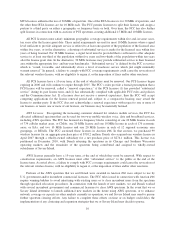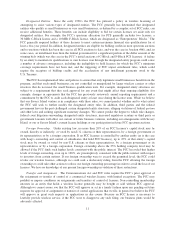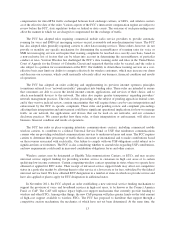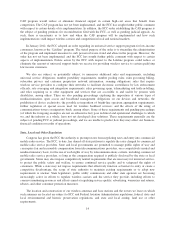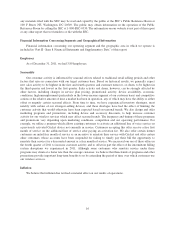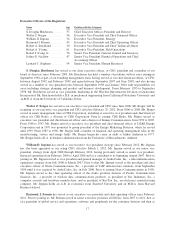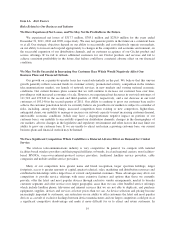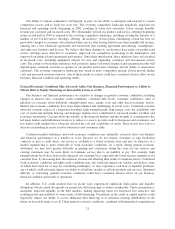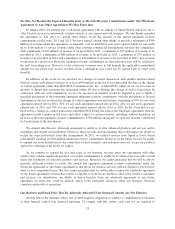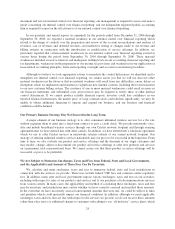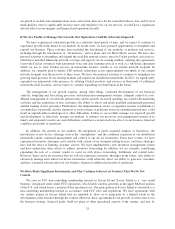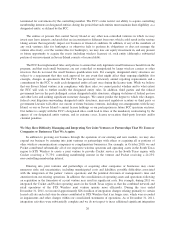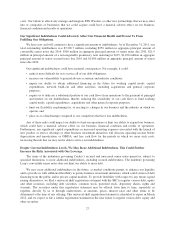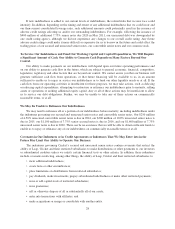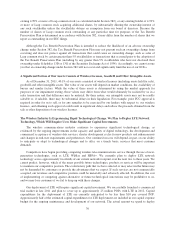Cricket Wireless 2011 Annual Report Download - page 30
Download and view the complete annual report
Please find page 30 of the 2011 Cricket Wireless annual report below. You can navigate through the pages in the report by either clicking on the pages listed below, or by using the keyword search tool below to find specific information within the annual report.addition, some of our competitors are able to offer their customers roaming services at lower rates. As
consolidation in the industry creates even larger competitors, advantages that our competitors may have, as well
as their bargaining power as wholesale providers of roaming services, may increase. For example, in connection
with the offering of our nationwide voice and data roaming services, we have encountered problems with certain
large wireless carriers in negotiating terms for roaming arrangements that we believe are reasonable, and we
believe that consolidation has contributed significantly to some carriers’ control over the terms and conditions of
wholesale roaming services.
The competitive pressures of the wireless telecommunications industry and the attractive growth prospects
in the prepaid segment have continued to increase and have caused a number of our competitors to offer
competitively-priced unlimited prepaid and postpaid service offerings or increasingly large bundles of minutes of
use at increasingly lower prices, which are competing with the predictable and unlimited Cricket Wireless service
plans. For example, AT&T, Sprint Nextel, T-Mobile and Verizon Wireless each now offer unlimited service
offerings. Sprint Nextel also offers competitively-priced unlimited service offerings under its Boost Unlimited
and Virgin Mobile brands, which are similar to our Cricket Wireless service. T-Mobile also offers an unlimited
plan that is competitively priced with our Cricket Wireless service. In addition, a number of MVNOs offer
competitively-priced service offerings. For example, Tracfone Wireless sells wireless offerings in Wal-Mart
under its “Straight Talk” brand using a number of carriers’ wireless networks. We also face additional
competition in the prepaid segment from lifeline service offerings by competitors including Tracfone (through its
SafeLink offerings) and Sprint Nextel (through its Assurance Wireless offerings). Lifeline services are available
to consumers at reduced costs (and in some cases at no cost) because carriers offering this service receive a
subsidy payment from the federal USF program. Moreover, some competitors offer prepaid wireless plans that
are being advertised heavily to the same demographic segments we target. These various service offerings have
presented, and are expected to continue to present, strong competition in markets in which our offerings overlap.
In addition to our voice offerings, many companies offer other products and services that compete with
those we offer. For example, there are numerous music services that compete with our Muve Music service,
including the iTunes service offered by Apple, Inc. and various streaming services offered by Rhapsody,
Pandora, Spotify and others. In addition, there are a number of mobile broadband services that compete with our
Cricket Broadband service, including those offered by AT&T, Sprint Nextel, T-Mobile and Verizon Wireless. In
addition, Clearwire Corporation has launched unlimited 4G wireless broadband service in a number of markets in
which we offer Cricket Broadband. Best Buy also offers a mobile broadband product using Sprint’s wireless
network. These service offerings have presented, and are expected to continue to present, strong competition in
markets in which our service offerings overlap.
We may also face additional competition from new entrants in the wireless marketplace, many of whom
may have significantly more resources than we do. The FCC is pursuing policies designed to increase the number
of wireless licenses and spectrum available for the provision of voice, data and mobile broadband services in
each of our markets, as well as policies to increase the level of intermodal broadband competition. For example,
the FCC has adopted rules that allow the partitioning, disaggregation and leasing of wireless licenses, which may
increase the number of our competitors. The FCC announced in March 2010, as part of its National Broadband
Plan, the goal of making an additional 500 MHz of spectrum available for broadband use within the next
10 years, of which the FCC stated that 300 MHz should be made available for mobile use within five years. The
FCC has also adopted policies to allow satellite operators to use portions of their spectrum for ancillary terrestrial
use and recently made further changes intended to facilitate the terrestrial use of this spectrum for voice, data and
mobile broadband services. Taking advantage of such developments, at least one new entrant, LightSquared, has
announced plans to launch a new wholesale, nationwide 4G-LTE wireless broadband network integrated with
satellite coverage to allow partners to offer terrestrial-only, satellite-only or integrated satellite-terrestrial services
to their customers. The FCC has also permitted the offering of broadband services over power lines. The auction
and licensing of new spectrum, the re-purposing of other spectrum or the pursuit of policies designed to
encourage broadband adoption across wireline and wireless platforms may result in new or existing competitors
acquiring additional capacity, which could allow them to offer services that we may not be able to offer cost
effectively, or at all, with the licenses we hold or to which we have access.
20


